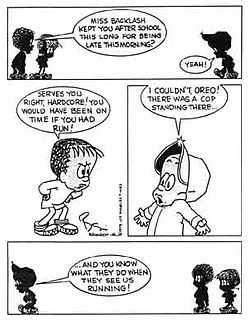Luther (comic strip)
| Luther | |
|---|---|
| Author(s) | Brumsic Brandon Jr. |
| Current status / schedule | Concluded |
| Launch date | 1969 |
| End date | 1986 |
| Syndicate(s) | Los Angeles Times Syndicate |
| Genre(s) | comedy-drama |
Luther is an American syndicated newspaper comic strip published from 1969 to 1986, created and produced by cartoonist Brumsic Brandon Jr. The series, about an African-American elementary-school child, was the second mainstream comic strip to star an African-American in the lead role, following Dateline: Danger! (1968-1974), the first to do so. Another predecessor, Wee Pals (1965- ), features an African-American among an ensemble cast of different races and ethnicities.
Publication history

Brumsic Brandon Jr. (b. 1927), who published his first cartoon in 1945, did editorial cartoons before conceiving of a comic strip about inner-city African-American children and a gently satirical theme about the struggle for racial equality.[1][2] He named his title character, a third-grader, after Civil Rights activist the Rev. Dr. Martin Luther King Jr.[3]
The strip was first syndicated by the Reporters' News Syndicate[2] or by Newsday Specials[4] (sources differ), but was then picked up by the Los Angeles Times Syndicate.[2][4]
Brumsic's daughter, Barbara Brandon, who would grow up to become the first nationally syndicated female African-American cartoonist,[2] sometimes assisted her father with such tasks as applying Letratone, a transparent sheet with dots that read in print as African-American skin tone.[5]
Cast
Source:[2]
- Luther, a third grader
- Hardcore, his classmate, who wears a baseball cap
- Pee Wee, their friend, a kindergartener
- Mary Frances and Oreo, two African-American girls
- Lily, a blond Caucasian girl
- Miss Backlash, the third-grade teacher
The children attended the Alabaster Avenue Elementary School.[6]
Critical analysis
Cartoon historian Maurice Horn wrote that, "Although his gags were often about racism, Brandon was also successful in using his nicely designed urban inner-city kids to get his message of racial equality across."[2]
The African-American artist and essayist Oliver W. Harrington wrote in 1976[6] that with Luther,
The cartoonist is actually violating what has always been an American taboo, and that is to create non-white characters or even poor white characters who are human, sympathetic and even lovable. Brandon employs his irresistible humor to level the walls of racism. And what better stage setting could he devise than the schools and the kids they're trying to educate.[7]
Luther collections
- Luther from Inner City (Independent Publishers Group, 1969; ISBN 0-8397-5650-X; ISBN 978-0-8397-5650-7)
- Luther Tells It as It Is! (Paul S. Eriksson, 1970; ISBN 0-8397-5670-4; ISBN 978-0-8397-5670-5)
- Right on, Luther! (Paul S, Eriksson, 1971; ISBN 0839770758; ISBN 978-0839770756)
- Luther Raps (Paul S, Eriksson, 1971; ISBN 0839756658; ISBN 978-0839756651)
- Outta Sight Luther (Paul S. Eriksson, 1972; ISBN 0839764812; ISBN 978-0839764816)
- Luther's Got Class (Paul S. Eriksson, 1976; ISBN 0839756682; ISBN 978-0839756682)
See also
References
- ↑ Brumsic Brandon Jr. at the Lambiek Comiclopedia. Archived from the original on May 1, 2014.
- ↑ 2.0 2.1 2.2 2.3 2.4 2.5 Horn, Maurice, ed. (1996). 100 Years of American Newspaper Comics. New York York: Gramercy Books. pp. 190–191. ISBN 0-517-12447-5.
- ↑ McGrath, Ben (April 19, 2004). "The Radical: Why do editors keep throwing 'The Boondocks' off the funnies page?". The New Yorker. Archived from the original on November 5, 2012. Retrieved 2014-05-01.
- ↑ 4.0 4.1 "'Coloring Outside the Lines: Black Cartoonists as Social Commentators' exhibit to open at Laney". Oakland Local. August 6, 2010. Archived from the original on August 23, 2010. Retrieved February 23, 2014.
- ↑ Jones, Lisa (2010). Bulletproof Diva. Anchor Books. p. 89. ISBN 978-0-307-77381-4.
- ↑ 6.0 6.1 Johnson, Charles Richard; Byrd, Rudolph P., ed. (1999). I Call Myself an Artist: Writings by and about Charles Johnson. Indiana University Press. p. 208. ISBN 978-0253335418.
- ↑ Harrington, Oliver W. (1993). Why I Left America, and Other Essays. University Press of Mississippi. p. 87. ISBN 978-0878056552.
External links
- Bruning, Fred (May 10, 1994). "Cartoonist Barbara Brandon Was Born To The Business". Newsday via the Deseret News. Archived from the original on May 1, 2014. Retrieved 2014-05-01.